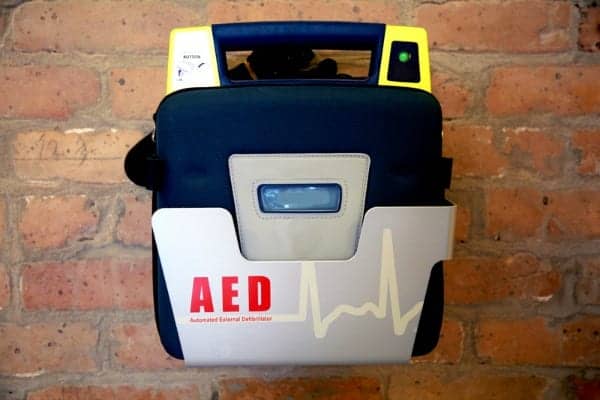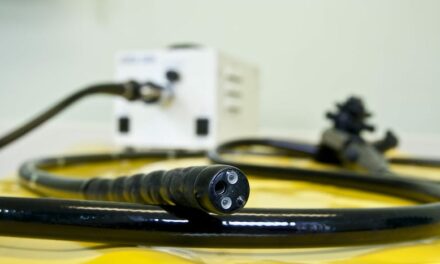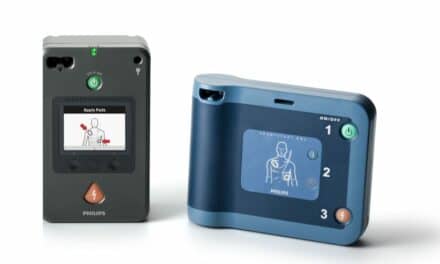By Arthur Zenian
There are many differences between an automated external defibrillator (AED) and a “standard” defibrillator. Standard, or advanced life support (ALS), defibrillators are used by healthcare professionals in hospitals and ambulances. These devices allow professionals to monitor the patient rhythm and manually intervene if it is determined that a shock is required. Most of these units also offer an advisory or AED function, in which waveform analysis and shock recommendations are made based upon sophisticated algorithms contained within the device. ALS units can be used with either paddles or electrode pads, and they are meant for use by trained medical professionals only.
AEDs are considered public access devices designed to be used by anyone, trained or not. The device walks the user through the rescue until emergency medical services arrives or the victim is revived. It analyzes the heart rhythm every two minutes to determine whether a shock is needed. It will not shock unless it detects a shockable rhythm, no matter how many times someone presses the shock button. It uses disposable adhesive electrode pads that deliver shocks at a set level of energy measured in joules (J). Some AEDs use escalating energy (higher joules) for additional shocks on the same victim.
Clinical Application
Heart rhythms are regulated by an internal pacemaker called the sinoatrial (SA) node located in the right atrium of the heart. Failure of the SA node to produce a normal sinus rhythm (NSR) can lead to various arrhythmias, such as atrial fibrillation (A-Fib) or ventricular fibrillation (V-Fib):
- V-Fib is characterized by the uncoordinated fluttering of the two lower chambers of the heart (ventricles). This condition is extremely dangerous because no blood is transported through the circulatory system. V-fib requires an immediate unsynchronized shock across the heart to restore NSR.
- A-Fib occurs when the two upper chambers (atria) beat rapidly and irregularly, resulting in poor blood circulation to the body. This condition can be remedied with a defibrillator through synchronized cardioversion, where an electrical shock is applied to the heart precisely during the “R” portion of the QRS complex.
Defibrillators are useful to resolve both of these conditions, but it is important to note that these devices are not effective during the absence of electrical activity in the heart commonly known as “asystole” or “flat line.” There must be some electrical activity in the heart for a defibrillator to be effective.
Defibrillator and AED Basics
Defibrillators have two hard paddles and/or adhesive pads—labeled as “sternum” and “apex”—that are placed across the patient’s chest to provide a pathway to guide the corrective extrinsic electrical shock. In the most basic terms, defibrillators charge an internal capacitor to a set voltage and deliver the prescribed energy. One joule of electrical energy is equal to the work done when a current of one ampere is passed through a resistance of one ohm for one second. To deliver the correct amount of current across the heart muscle, the defibrillator voltage is varied in accordance to the impedance in the patient’s chest. Ohm’s law states that current=voltage/impedance.
Size Matters
Defibrillator supplies and settings are divided between two categories, adult and pediatric. The power of the therapeutic shock is determined by patient weight. The 2010 American Heart Association Guidelines state that, “with a manual defibrillator (monophasic or biphasic), use a dose of 2 J/kg for the first attempt and 4 J/kg for subsequent attempts.” In order to account for the physiological differences between an adult and child, either pediatric specialty paddles or pediatric electrode pads are used. Pediatric electrode pads often have internal circuitry that acts as a safety feature to limit shock magnitude.
Preventive Maintenance Tips
Judicious device management will greatly assist in the reduction of adverse incidents and medical device-related accidents in AEDs. The Medicine and Healthcare Products Regulatory Agency declares that maintenance activities and their intervals should be planned in accordance with the manufacturers’ recommendations or strategies listed in an alternative equipment maintenance program. As such, these alternative program strategies must be based on valid standards of practice.
Arthur Zenian is CEO of enBio Corp. based in Burbank, Calif. Questions and comments can be directed to 24×7 Magazine chief editor Keri Forsythe-Stephens at [email protected].





